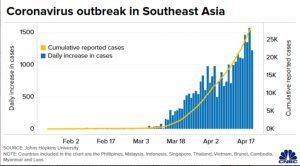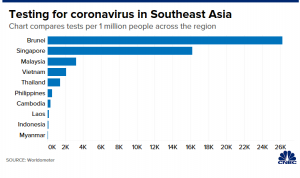https://www.cnbc.com/2020/04/20/southeast-asia-could-be-the-next-coronavirus-hot-spot-these-charts-show-why.html
This article that I got is from CNBC and it talks about Southeast Asia can be the next coronavirus case hotspot in the country.
As you all know that the coronavirus is a pandemic virus that is worldwide now. In the article, it says that Southeast Asia's coronavirus infections has risen quickly in the past recent weeks. Mounting worries with experts say that the regions can turn into a hotspot for the fast spreading disease.
As a whole region, it has reported more than 28,000 cases as of Sunday, according to the data by John Hopkins University. Indonesia, the Philippines, Malaysia and Singapore account for 87.9% of total cases reported in Southeast Asia, of what the data showed. in Singapore, cases have spiked dramatically in the last two weeks, with new clusters of infections found among migrant workers living in packed dorms.
As you can see in this chart, it had dramatically increased within weeks.
Varying testing capacity
Capacity to test for the coronavirus vary widely across Southeast Asia. Singapore is among the top globally with 16,203 tests per million people, while Myanmar is close to the bottom with just 85 tests per million people in the population. Expert say that the Philippines and Indonesia have mostly singled out as they are concerned about them two countries being the largest in the region with population.
Indonesia, which has the world's fourth-largest population of over 270 million, has conducted around 42,000 tests in total. That is equivalent to 154 tests per million people.
Overall, in this article, it talks about Southeast Asia could be the next coronavirus hotspot. In my blog post, I added some charts to show some increasing charts and numbers. In the article itself, there are ore charts that are shown.


